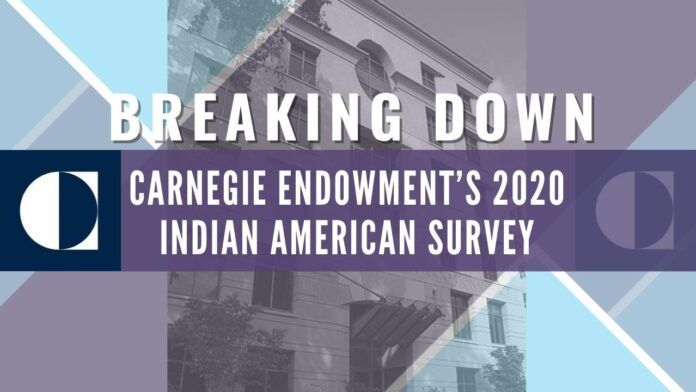
Carnegie Endowment report – Much to appreciate but still questionable
Earlier this week, the Carnegie Endowment for International Peace released a survey on Indian Americans, charting the “everyday social realities that Indian Americans experience[1].” It reveals some important data on the 4 Million strong Indian American community, including ongoing social realities, religious practices, attitudes towards civic and political engagement, social networks, etc. On analyzing the report, there is much to appreciate but also much to question-specifically with regards to the findings around “caste.”
Exposes poor quality of data powering the current politics of “caste”
Over the past year multiple state-sponsored bodies, especially in California, have sponsored resolutions or sought to make “caste” a protected category, based primarily on the faulty research and positions of Equality Labs. The Carnegie report references the same 2018 “Caste Survey” and in Footnote 29 punches a big hole into the false propaganda of the group and their allies. The Carnegie report asserts that the Equality Labs survey does not fully represent the South Asian American population, likely has skewed data, and thus the intensity of “caste discrimination” can be contested.

Carnegie’s statement asserting that “it is likely that the sample does not fully represent the South Asian American population and could skew in favour of those who have strong views about caste…” is exactly what many Hindu activists and those who work with surveys have been saying for years.
Given this background, we urge the California Department of Fair Employment and Housing (CDFEH), the Human Rights Commission of Santa Clara County and the student bodies of Cal Poly, UC Davis and others to re-evaluate their statements and resolutions based on this same flawed data and stop the Hinduphobia.
Contradictions within the Carnegie Survey Report
On the whole, it is unfortunate that colonial categories like “caste” continue to be kept alive through standardizations like these, long after the colonizers have departed. Even more, unfortunately, the survey queries only those respondents self-identifying as Hindu- regarding their “caste.” This defies logic. If Indian laws are to be our guide in the U.S. (which appears to be the case for the Carnegie survey), we can find hundreds of “castes” among India’s Christians, Muslims and Sikhs [2] [3] [4]. These categories are well defined in India among all communities, not just among the Hindus [5].
The focus on probing and trying to link Hinduism alone to “caste” takes away from an otherwise very credible survey and reinforces stereotypes about Hinduism in the minds of the readers. In fact, Carnegie admits that the Other Backward Caste (OBC) category is common among Muslims, (see a snapshot from their report below) while the Scheduled Castes (SC) category is found among Buddhists, Sikhs, Christians and Muslims.
Another inconsistency is apparent in Footnote 7, which states: “The term ‘Dalit’ refers to individuals who occupy the lowermost rungs of the traditional Hindu caste hierarchy.” Not only does this footnote contradict the report it is part of, it, unfortunately, shows bias against Hinduism yet again, since Dalits also exist among Muslims, Christians, Sikhs, etc.

Flawed assumptions
The Carnegie survey assumes and builds questions around a “traditional Hindu caste hierarchy.” What could this tradition be, when “caste” is a Portuguese word not found in ANY Hindu text? As Professor Nicholas Dirks wrote, British “caste” censuses force-fitted thousands of jatis and occupation-based groups into a “caste hierarchy” and then blamed Hindus for all problems [6].
Similarly, what does “identifying with caste” mean? If Carnegie is interested in Hindu beliefs, the questions should probe on categories like jati, varna, kula, gotra, shreni, etc. These are Hindu concepts, not “caste,” which is a colonial import. A good reading list on these topics can be found in the link below[7].
Caste does not rise as a significant factor in the survey
In Figures 19 and 21, we see two key observations. First, a quarter of respondents had NO knowledge of “caste” in their networks, while barely twenty-one per cent of an already tiny group of self-selected respondents even think “caste” is an issue, in formation of their social networks.
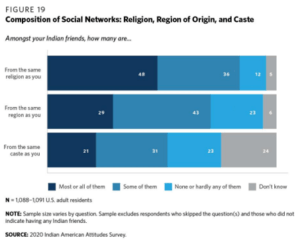
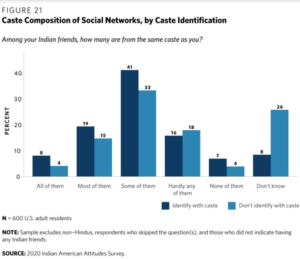
Nor is this affinity of like-minded folks to cluster together an anomaly. A study in August 2020, showed similar results among social networks of different Christian religious groups within the US. See chart below[8].

Next, consider Figures 27 & 28. While the institute points out that “caste” discrimination is “an equal opportunity offence,” (28), it also urges to exercise care in any “subgroup analysis” due to the small sample size (27). We certainly agree with the latter.
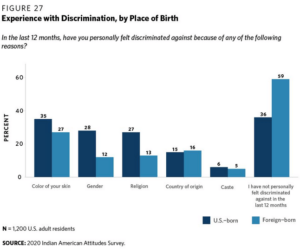
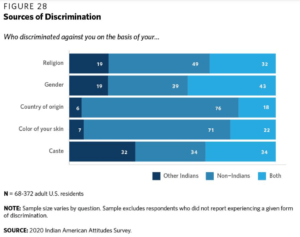
This is important because only five per cent of respondents (of a very small self-selected sample) reported experiencing any such “caste” discrimination over the past twelve months. So, any assertions about “caste” need to be taken with a grain of salt.
In conclusion, while the Carnegie Endowment Survey on Indian Americans has pertinent data on the social and demographic trends within the community, its association of “caste” solely with Hinduism is problematic and reinforces stereotypes about Hindus even when the survey finds negligible “caste” discrimination within the community. Still, It is a breath of fresh air to see that Carnegie Endowment challenges and cautions against the 2018 Equality Labs survey that has been the basis of a virulent Hinduphobic sentiment in the United States and beyond.
Note:
1. Text in Blue points to additional data on the topic.
2. The views expressed here are those of the author and do not necessarily represent or reflect the views of PGurus.
References:
[1] Social Realities of Indian Americans: Results From the 2020 Indian American Attitudes Survey – June 9, 2021, carnegieendowment.org
[2] Indian Dalits find no refuge from caste in Christianity – Sep 14, 2020, BBC.com
[3] India’s Muslim community under a churn: 85% backward Pasmandas up against 15% Ashrafs – May 13, 2019, The Print
[4]How Punjab’s Dalits fight over a piece of land for dignity, not profit – Aug 8, 2019, Business Standard
[5]National Commission for Backward Classes, A Constitutional Body under Article 338B of the Constitution of India under the Ministry of Social Justice & Empowerment – NCBC.nic.in
[6]Transformations comparative study of social transformations – Oct 1988, deepblue.lib.umich.edu
[7]DECONSTRUCTING “CASTE,” THE COLONIAL TROPE – cohna.org
[8] Religious diversity and change in American social networks: How our social connections shape religious beliefs and behavior – Dec 15, 2020, American Survey Center

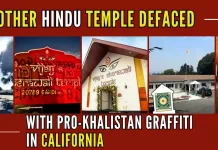









[…] group with a track record of conducting surveys. It found that the majority of Indian Americans did not identify themselves with caste at all, with a quarter denying any knowledge of caste in their networks. Thus no overwhelming caste-based […]
Every thing is done with a purpose to direct the.mind.
By way of Endowment funds in Universities and think tanks since their inception since 1916.
They provide what they are paid for.